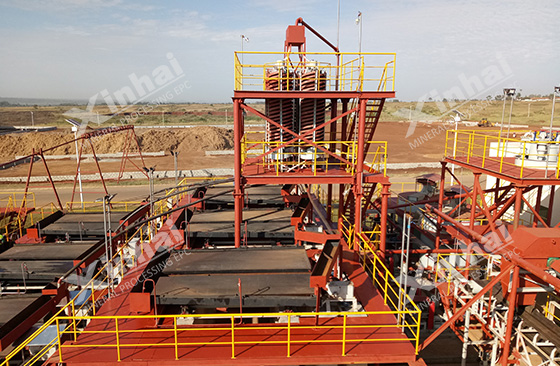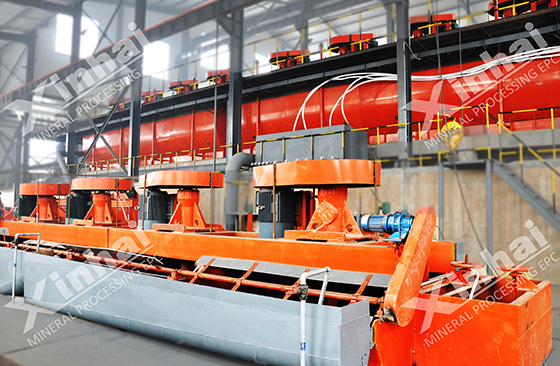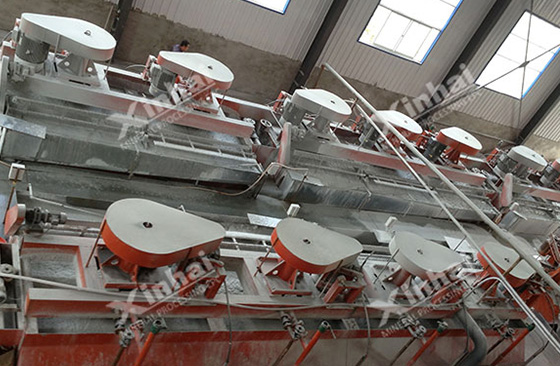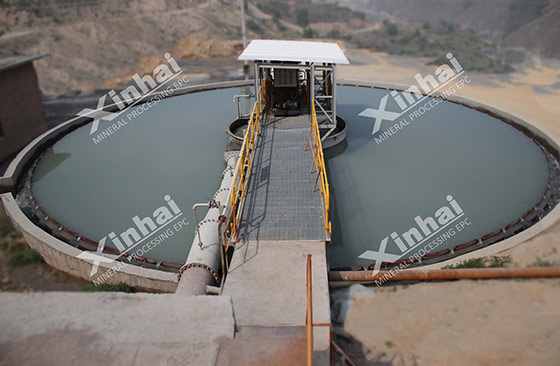
According to the dissipation characteristics of the ore, scheelite can use gravity separation, a combination of gravity separation and flotation, or a single flotation method. Different scheelites have different types and contents of associated useful minerals, so their ore processing methods are also different. The following will introduce to you the gravity separation process of coarse-grained scheelite and the flotation process of fine-grained scheelite.

(Spiral chute + shaking table process)
The density of scheelite ore is 6.8g/cm³, which is similar to the density of wolframite ore, but its density is much greater than gangue minerals such as quartz, feldspar, calcite, fluorite, and garnet. Therefore, scheelite can choose to use gravity separation to separate gangue.
The scheelite is brittle and easily sludges during grinding. Therefore, after the scheelite has basically completed the monomer dissociation, it is necessary to recover the scheelite with a coarser grinding particle size as much as possible. Or use segmented grinding and segmented separation to gradually dissociate scheelite for recycling. The grinding process will produce products with uneven thickness, among which the gravity separation effect of fine-grained scheelite will become worse. Therefore, a combined gravity-floatation process is selected, that is, after the coarse-grained scheelite is gravity-separated, the fine-grained scheelite Carry out flotation. When there are both wolframite and scheelite in the ore, a single gravity separation or a combined gravity-floatation process can be used. The scheelite will be recovered along with the wolframite in the reselection. Gravity separation equipment such as spiral concentrators, spiral chutes, shakers and centrifugal concentrators can be used in scheelite gravity separation.

(flotation site)
Sulfide ore flotation: scheelite is often accompanied by sulfide minerals such as molybdenum, copper, bismuth, iron, lead, and zinc. The floatability of these sulfide minerals is better than that of scheelite, and they have the value of comprehensive recovery. If these sulfide ores are not fully recovered, they will enter the scheelite flotation operation, adversely affecting the flotation effect and often reducing the coarse concentrate and concentrate quality. Therefore, during the separation process of this type of ore, sulfide ore will be flotated first and then scheelite will be flotated.
Due to the different types of sulfide ores contained in different scheelite deposits, the separation processes for sulfide ores are different. 1. The grinding fineness must take into account both sulfide ore flotation and subsequent scheelite flotation; 2. It is necessary to fully recover the sulfide ore to avoid its entry into the tungsten flotation system and cause adverse effects; 3. The sulfide ore flotation reagent system ensures that the sulfide ore is Effective separation and recovery must also create certain conditions for scheelite flotation.

(flotation process)
Roughing of scheelite: Generally, scheelite has finer particle size and good floatability. Fine-grained scheelite is mainly recovered by flotation. Since the grade of scheelite raw ore is often low, it is difficult to achieve qualified concentrate grade requirements with only one flotation process. Therefore, scheelite generally adopts a two-stage flotation process, including roughing and concentrating. The scheelite roughing stage is to enrich the low-grade feed ore to a certain extent to obtain the scheelite coarse concentrate. The coarse concentrate is selected and enriched to the required quality of the product.
Because scheelite often contains calcium-containing gangue minerals with similar floating properties, such as fluorite, calcite, apatite, etc., the associated minerals of scheelite and other minerals are more complex, making their sorting more difficult, so scheelite Effective separation of ore and gangue minerals is the key to flotation separation. At present, scheelite roughing mainly adopts weak alkali medium-fatty acid hair, lime method and other methods.

(Tungsten ore processing)
Selection of scheelite: The coarse concentrate of scheelite flotation is not of high quality. The coarse concentrate still contains a lot of fine-grained fluorite, calcite and other calcium-containing gangue minerals. After the action of fatty acid collectors, these The floatability of gangue minerals is more similar to that of scheelite, so it is very difficult to separate them and requires special processing in the selection section. At present, the selection process can adopt heating selection process and normal temperature selection process.
The above are two types of scheelite ore processing methods. The scheelites at different stages contain different types of associated minerals and gangue minerals, and their adapted mineral separation methods are also different. Therefore, before processing scheelite, a beneficiation test analysis should be conducted to determine a reasonable beneficiation process and equipment, which can improve the recovery rate and utilization rate of scheelite concentrate.
To find out more about our products and solutions, please fill out the form below and one of our experts will get back to you shortly.